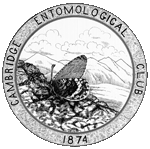
| January 2008: Psyche has a new publisher, Hindawi Publishing, and is accepting submissions |
Article beginning on page 60.
Psyche 15:60, 1908.
Full text (searchable PDF)
Durable link: http://psyche.entclub.org/15/15-060.html
The following unprocessed text is extracted from the PDF file, and is likely to be both incomplete and full of errors. Please consult the PDF file for the complete article.
60 PSYCHE [June
THE SCREW WORM (Chrysomyia macella'tia). In the Western Medical Review
for December, 1907, Dr. Henry B. Ward, under the title "Nebraska Case of the Screw Worm" gives the following interesting account of the habits of the larva of this fly. "Through the great courtesy of Dr. H. Winnett Orr of Lincoln, I have received recently a number of insect larvae which were taken from the nasal fossae of a patient. There were in all a very large number of these larvae, probably up- wards of two hundred, although only a few were saved. Their numbers and the extensive destruction of the tissues which took place during their growth in the host brought the trouble rapidly to a fatal termination in spite of all that could be done. The case was so unusual for Nebraska, and its outcome so serious that an exact determination of the species of insect and of its habits seemed imperatively demanded." The species is found throughout South America and a large portion of North America, especially in the tropical and subtropical regions. It is often very injurious to domestic animals. A small wound when infested, becoming a large and dangerous ulceration. In man they usually infest the nasal fossae, depositing its eggs in the nostril "to which it is usually attracted by a fetid catarrh. The larvse grow rapidly reaching maturity in five to eight days." "Of treatment, Manson (Trop. Dis., 4 ed. 787) says: 'If treated properly and in time by injections of chloroform, carbolic acid, turpentine, infusion pyrethorum and similar substances, the patient may be saved: neglected he will most probably die.'
In any event the mortality is large among these cases. Thus Laboulbene
lists 15 cases of which 9 were fatal; among the 31 cases collected by Maillard, 21 died. Both of these authors deal with records from South and Central America. In the United States I have found 55 to 60 cases published; in 31 a definite record was given as to course of the disease and its results, and in 22 of these the outcome was fatal." In the Jour. A. M. A. Dec. 7, Yount and Sudler report 23 cases from Arizona and New Mexico in 1905, only four of which were fatal. Owing to its wide distribution and variation some 27 specific names have been applied to this species. On the Atlantic coast the species is common as far north as New Jersey. Numerous specimens were taken on a dead shark at Truro, Mass., Sept. 4, 1904, and at Squantum, Mass., Oct. 9, 1905, by Mr. A. P. Morse. It has frequently been taken by Mr. Owen Bryant at Cohasset, Mass., in August. Mr. S. A. Shaw has found a specimen at Hampton, N. H., and the writer obtained a single specimen on a window of the Boston Society of Natural History, August 19, 1903.
C. W. JOHNSON.
================================================================================
Volume 15 table of contents